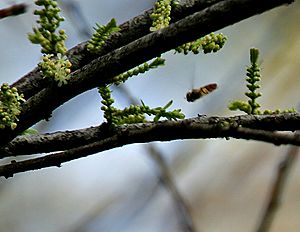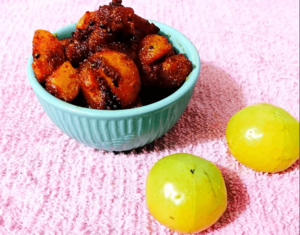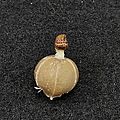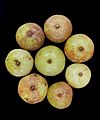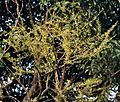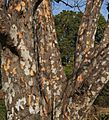Emblic facts for kids
Quick facts for kids Emblic |
|
|---|---|
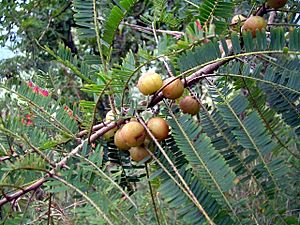 |
|
| Plant | |
 |
|
| Fruit | |
| Conservation status | |
| Scientific classification | |
| Genus: |
Phyllanthus
|
| Species: |
emblica
|
Phyllanthus emblica, also known as the Indian gooseberry or amla, is a special tree. It loses its leaves every year and belongs to the Phyllanthaceae family. This tree grows naturally in warm, tropical parts of southern Asia.
Contents
Plant Features and How We Get the Fruit
This tree is usually small to medium-sized, growing about 1 to 8 meters tall. Its branches are 10 to 20 centimeters long. The leaves are simple, light green, and grow close together along the branches, looking a bit like feathers. The flowers are a greenish-yellow color.
The fruit is almost perfectly round and light greenish-yellow. It looks smooth and firm, with six vertical lines or grooves. Wild fruits weigh about 5.5 grams, but fruits grown on farms can be much bigger, weighing from 28.4 to 56 grams.
The berries ripen in autumn. People pick them by hand, often climbing up into the tree's upper branches. The Indian gooseberry tastes sour, bitter, and a bit rough. It also has a lot of fiber.
Buddhist Meaning
The Indian gooseberry fruit is mentioned many times in Buddhist traditions. For example, one ancient text says that Buddha's knowledge is so complete, it's like holding an amla fruit in the palm of your hand. This means he understands everything clearly.
A great Indian emperor named Ashoka gave half an amla fruit as his last gift to the Buddhist community. An old story about Ashoka says he went from being the ruler of a huge land to only owning half a myrobalan fruit. This shows his great generosity. In Theravada Buddhism, people believe that the twenty-first Buddha, named Phussa Buddha, reached enlightenment under this very tree.
Traditional Uses
Cooking with Amla
People eat the amla fruit raw or cook it into different dishes. It is often added to dal, which is a lentil soup. Another popular sweet dish is amle ka murabbah, made by soaking the berries in sugar syrup until they become like candy. People traditionally eat this sweet dish after meals.
In Sumatra, Indonesia, the inner bark of the tree is used. It gives a bitter taste to a traditional fish soup called holat.
Amla in Traditional Medicine
In Ayurveda, which is a traditional Indian system of medicine, both fresh and dried amla fruits are used a lot. They are a common ingredient in many traditional remedies.
Gallery
-
Amla at the top of the Lingaraj temple in Bhubaneswar
-
Hand of a standing Buddha statue holding a myrobalan
-
Amala in Bhopal Madhya Pradesh
See also
 In Spanish: Phyllanthus emblica para niños
In Spanish: Phyllanthus emblica para niños



